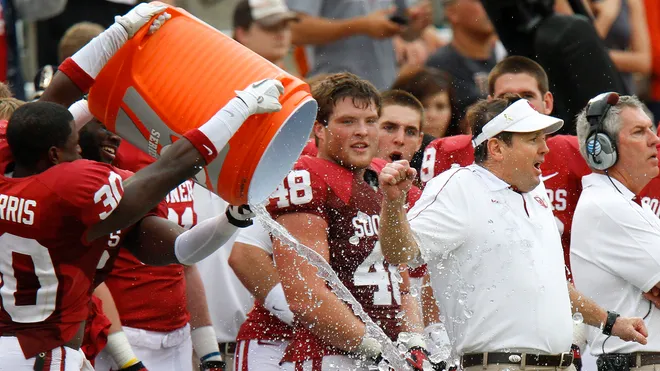In the USA TODAY Sports Coaches Polls for the past 25 years, where does Oklahoma stand?

The USA TODAY Sports Coaches Poll has been one of the most respected and influential rankings in college football for decades. This poll, which is based on the votes of 63 head coaches across the nation, provides an annual snapshot of how the top programs in the country stack up against each other. For the University of Oklahoma, a program rich in history and tradition, the Coaches Poll is more than just a ranking—it’s a reflection of the team’s success, its standing among the elite, and its ongoing pursuit of national championships.
Over the past 25 years, Oklahoma has firmly established itself as one of the premier programs in college football, consistently appearing near the top of the Coaches Poll. The Sooners have not only been a mainstay in the poll but have also had some dominant seasons that helped solidify their place among the nation’s elite. This article explores Oklahoma’s position in the USA TODAY Sports Coaches Poll over the past quarter-century, examining how the program has performed, the key moments that shaped its ranking, and how it has maintained its national prominence.
Oklahoma’s Consistency in the Coaches Poll
Since the mid-1990s, Oklahoma has been a constant presence in the USA TODAY Sports Coaches Poll, with very few seasons in which the Sooners failed to be ranked. This level of consistency speaks to the program’s sustained success, which has been built on strong recruiting, excellent coaching, and a tradition of excellence. The Sooners have been a model of consistency in terms of being competitive year in and year out, which is a major reason why they’ve been able to stay ranked so highly for such a long period.
One of the key factors behind Oklahoma’s consistency in the Coaches Poll is the stability of its coaching staff. The program has had some turnover, but it has also been led by some legendary coaches over the past 25 years. In particular, Bob Stoops, who served as head coach from 1999 to 2016, was instrumental in the program’s sustained excellence, leading the Sooners to a national championship in 2000 and making numerous BCS and College Football Playoff (CFP) appearances.
Stoops’ successor, Lincoln Riley, continued this tradition of success, even though his tenure at Oklahoma was shorter (2017–2021) before he moved on to become the head coach at USC. Under Riley, Oklahoma was regularly ranked near the top of the Coaches Poll and maintained a potent offense and competitive teams. As of 2022, Brent Venables, a former Oklahoma assistant coach and defensive coordinator, took over as head coach, and while it was a transitional period, the expectations for Oklahoma remain high due to its legacy of sustained excellence.
Oklahoma’s Ranking Over the Years
Late 1990s to Early 2000s: The Rise of Bob Stoops
When Bob Stoops took over the Oklahoma program in 1999, the Sooners were coming off a period of mediocrity and inconsistency. Under Stoops, Oklahoma quickly became one of the most dominant programs in the country. Stoops led the Sooners to a national championship in 2000, and in doing so, the Sooners jumped to No. 1 in the Coaches Poll. This victory marked the beginning of a remarkable stretch for the Sooners, one in which they were regular fixtures in the top 10 of the Coaches Poll.
The Sooners finished the 2000 season ranked No. 1 after a dominant performance in the Orange Bowl, defeating Florida State 13–2 in the national championship game. In 2001, they finished the season ranked No. 2 in the Coaches Poll, and they continued to be ranked in the top 5 or top 10 for most of Stoops’ tenure. The 2003 season, in particular, saw Oklahoma reach the BCS National Championship Game, where they were ranked No. 1 throughout much of the season before ultimately losing to LSU in the Sugar Bowl. The Sooners finished the 2003 season ranked No. 3, but they were still a fixture at the top of the Coaches Poll.
2000s: Continued Success and Domination in the Big 12
In the 2000s, Oklahoma continued to dominate the Big 12 Conference and stay near the top of the Coaches Poll. The Sooners went to a total of four BCS bowls between 2003 and 2010 and earned several Big 12 titles. Their consistent success on the field made them a regular presence in the top 10 of the Coaches Poll, and in many seasons, they finished in the top 5.
Oklahoma’s offense, led by quarterbacks like Jason White (who won the 2003 Heisman Trophy) and Sam Bradford, kept the team relevant and competitive on a national scale. The Sooners were known for their high-powered offense and aggressive defense, a combination that kept them ranked among the nation’s elite teams throughout the 2000s. In 2008, they finished the season ranked No. 2 in the Coaches Poll after a near-perfect regular season and an appearance in the BCS National Championship Game, where they fell to Florida.
2010s: Lincoln Riley’s Offensive Revolution and Playoff Appearances
The 2010s marked a new chapter for Oklahoma football, as Lincoln Riley took over as offensive coordinator in 2015 and later became the head coach in 2017 after Stoops’ retirement. Under Riley, Oklahoma’s offense became even more explosive, with quarterbacks like Baker Mayfield and Kyler Murray leading the team to multiple College Football Playoff (CFP) appearances.
Oklahoma’s inclusion in the CFP marked a new era for the program. They appeared in the playoff four times in five seasons (2015, 2017, 2018, and 2019), though they were unable to secure a national title during this stretch. However, their consistent presence in the top 10 of the Coaches Poll and regular CFP appearances highlighted the sustained excellence of the program.
Mayfield’s Heisman Trophy-winning season in 2017 helped propel the Sooners to a No. 2 ranking in the Coaches Poll, while Kyler Murray’s Heisman Trophy-winning season in 2018 kept the Sooners near the top of the rankings. Despite their regular appearances in the CFP, Oklahoma’s inability to win a national championship during this stretch was a major storyline, but their position in the Coaches Poll remained high. The Sooners finished 2018 ranked No. 4 and 2019 ranked No. 5.
2020s: A New Era Under Brent Venables
In 2022, Oklahoma ushered in a new era with the hiring of Brent Venables as head coach. Venables, a former assistant at Oklahoma, is known for his defensive expertise, and the program has hoped that his leadership will bring a fresh approach to Oklahoma’s already successful formula.
In his first season, the Sooners faced challenges, as they went through a rebuilding process. Oklahoma was still ranked in the Coaches Poll, but the team’s performance was inconsistent at times. However, the foundation that Venables is building at Oklahoma is one that should keep the Sooners competitive on a national level for years to come. The 2022 season served as a transitional year, but the program remains a force to be reckoned with in the Big 12 and, in the near future, in the SEC.
Key Factors That Contributed to Oklahoma’s Success in the Coaches Poll
Oklahoma’s dominance in the Coaches Poll over the past 25 years can be attributed to several factors:
- Elite Coaching: From Bob Stoops to Lincoln Riley and Brent Venables, Oklahoma has been led by high-quality coaches who have understood the importance of consistency, recruitment, and player development. Each of these coaches has left an indelible mark on the program, contributing to Oklahoma’s high ranking in the Coaches Poll.
- Quarterback Play: Throughout the 25-year period, Oklahoma has produced some of the best quarterbacks in college football. The Heisman Trophy-winning seasons of quarterbacks like Jason White, Sam Bradford, Baker Mayfield, and Kyler Murray helped propel the Sooners to national prominence and high rankings in the Coaches Poll. The program’s ability to consistently develop elite quarterbacks has been a hallmark of its success.
- Strong Recruiting: Oklahoma has consistently recruited at a high level, attracting top talent to Norman, Oklahoma. This has allowed the program to stay competitive not just in the Big 12 but on a national level. Recruiting top-notch players at every position, especially at key positions like quarterback and defensive line, has been crucial to Oklahoma’s success in the Coaches Poll.
- Big 12 Dominance: For much of the past 25 years, Oklahoma has been the dominant team in the Big 12, often finishing the regular season with a strong conference record and competing for conference championships. This success has translated into high rankings in the Coaches Poll, as teams from strong conferences tend to get more attention from voters.









